"Keep an Eye on Your Kidneys!"
Shooting my first documentary film.
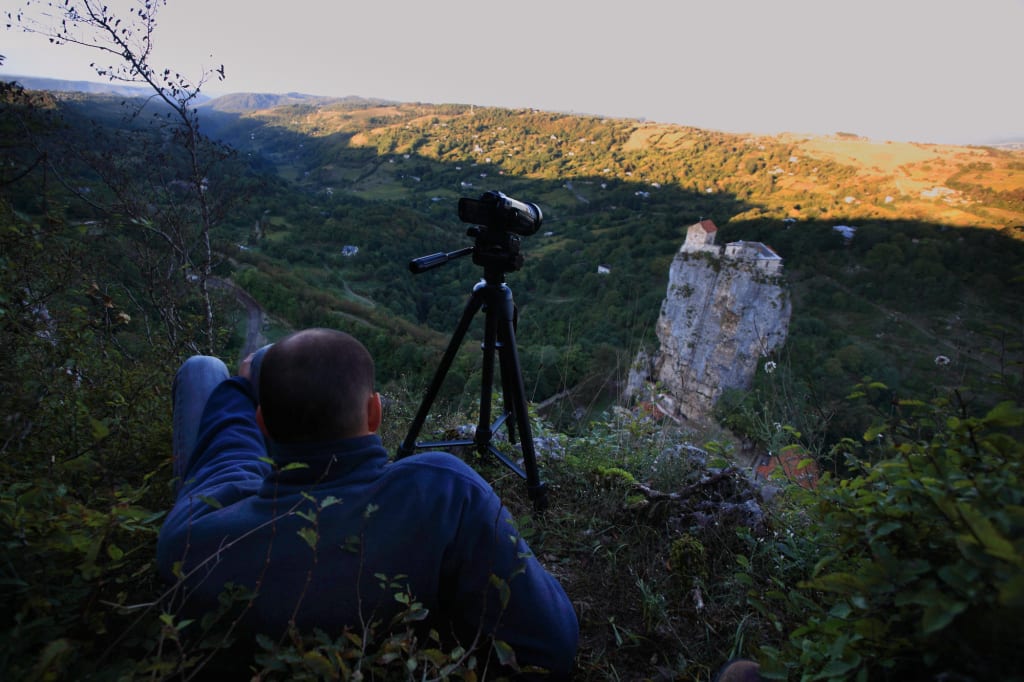
My journey to Georgia, the country not the state, began almost a decade earlier with a treatment for a short film. Being interested in religious history, I dreamed up a character whose obsession with Saint Simeon Stylites leads him to climb a cellphone tower to live as a modern day stylite. As expected, his community reacts strongly. After some initial work, I set it aside.
In 2010 I took it up again and, while researching stylite asceticism, happened on Georgian photojournalist, Temo Bardzimashvili’s photo essay titled, Georgian Monk Builds Stairway to Heaven. I was shocked to find that there was someone aspiring to become a stylite, a form of asceticism long thought to be extinct. It was as if my character had come to life.
After a year of corresponding with Temo, I was finally able to travel to the Republic of Georgia to scout locations, see the pillar, meet Father Maxim, and hopefully bring back a short prologue for the documentary I wanted to make. It’s important to note here that I do not speak Georgian or even Russian for that matter. I was communicating with Temo in English and hoped that he could act as my guide, interpreter, and as a DP, since it was clear that we had a similar photographic sense.
Although I love to travel and immerse myself in different cultures, I’m usually more prepared than I was when I decided to go to Georgia. A year of study in Japan taught me the importance of communicating with people in their own language (however haltingly). With Georgia, it was all unknown, and I really couldn’t blame my family for saying, “Don’t get kidnapped” and “Keep an eye on your kidneys”, since there was a story at that time about organs being harvested from drugged travelers visiting former Soviet republics.
Caution to the Wind, This Film Is Worth a Kidney
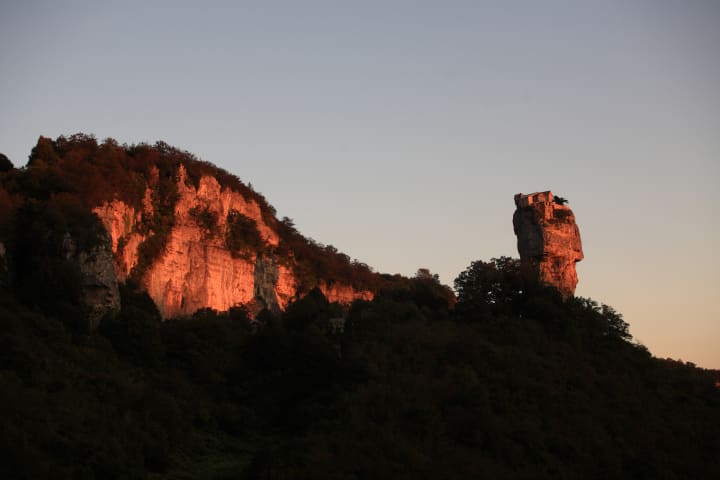
It was Temo’s amazing photographs that compelled me to throw my usual caution to the wind, not to mention the seeming serendipity of even finding his photo essay in an obscure English language Georgian magazine. His story about Father Maxim rebuilding a hermitage that sits atop a one hundred thirty-foot limestone monolith only further whetted my appetite.
For the first time, the short outline of my fictional story, Father Maxim’s true story, and Katskhi Pillar-the monolith itself, began to coalesce and form a vague outline for a creative documentary that I was planning to title, The Stylite: a matter of faith.
As I flew across the Atlantic trying to memorize basic greetings in Georgian, as well as more practical statements such as, “Where’s the bathroom?” and “How do I get to [Hostel name here]?”, I began to plan the next ten days. I was to spend a few days in Tbilisi to get a feel for the capitol and pitch the film to the Georgian National Film Center for a possible co-production. I would then live among the monks at the pillar for about a week, while documenting their daily lives. It would all culminate in a meeting with Father Maxim.
My “plan” was a very basic sketch. I seriously didn’t have a clue about what the next ten days would bring. I was literally counting on a stranger with whom I had only interacted with a handful of times, to meet me at an airport in a country I knew nothing about.
It was the most interesting (and probably the stupidest) thing I’ve ever done. But, as filmmakers, we are risk takers and sometimes we just need to take the first steps in a project on faith. For my first documentary, I happened to take mine, six thousand miles from home.
Customs Confessional
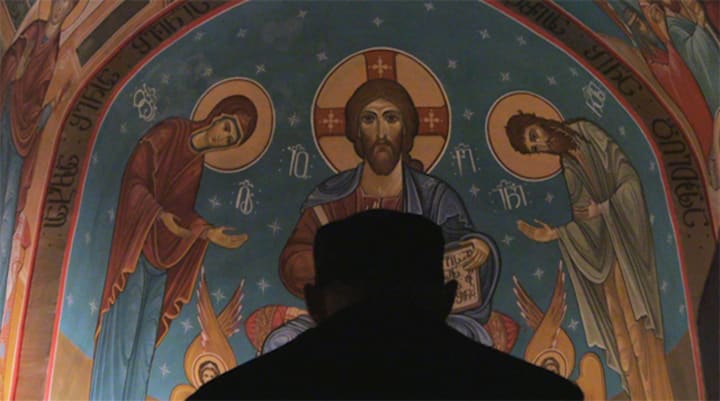
It is as good a time as any to share with you that I have always lived with one foot in the creative world and one in the practical world. I tried to make a living in the creative world, but did not like what I had to do to make that work. So instead, I use the practical world to help fund my creative work. The trade-off with this compartmentalization however, is that I rarely felt like a bonafide filmmaker.
I love to present our films at festivals, but I have a realist view of the whole thing. These are not major festivals, some are bigger and more prestigious than others, but none of the films being presented will be triggering a bidding war anytime soon. It is for this reason, that I feel out of place when I’m around filmmakers brimming with confidence, dragging their entourage around a hotel lobby that has been converted into a film festival for the weekend. At the same time, I have met many like-minded people at these events, which is why I continue to attend.
Yes, I know, I digress, but I want to impart this conflicted relationship I have with filmmaking. It will help you understand just how freeing it was for me to answer the stern looking Georgian customs officer fidgeting with his pen and eyeballing my backpack. Without blinking an eye or feeling like I was pretending, I told him that I was a filmmaker doing research for my next film. He asked if he had seen any of my films, I laughed and said that I doubted it, but he just might see the one I was there to research. Confused, he waved me through.
For ten days in Georgia, I was a full-time filmmaker. I wasn’t traveling for fun and planning to maybe shoot some footage on the side. No, I was in that country to plan a film and for no other reason. As I look back at that moment now, I still take strength in it. The barriers I had constructed between my work life, personal life, and filmmaking life began to fall away, which served to enhance all three in the process. Perhaps I was finally accepting my vocation nearly twenty years after embarking on it. As they say, it’s better late than never.
Beer in the Caucasus
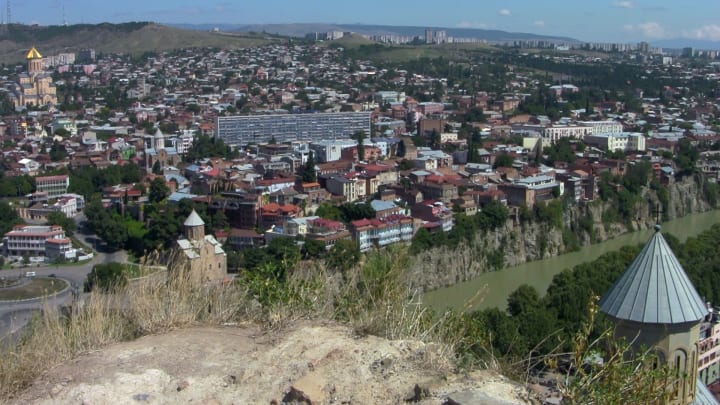
It was almost midnight when I finally got my baggage and exited the security doors. I was extremely nervous because I couldn’t really remember what Temo looked like. Looking around for a vaguely remembered face, Russian and Georgian sounds jockeyed for position. I couldn’t tell which was winning, both were confounding me equally. Finally, above the din, I heard the familiar consonants and vowels that make up my name. It was not a moment too soon since I was rapidly beginning to panic. I found myself staring into an abyss that had just swallowed up all the Georgian phrases I had memorized on the plane.
Though I worried that I wouldn’t recognize him, I’m sure the ‘deer in the headlights’ expression on my face stuck out to him like a sore thumb. As the lights from the airport receded, the anxiety loosened its grip, and subsided. That made room for another uncomfortable feeling. It occurred to me then that I hadn’t eaten in close to twenty hours. Relief again when Temo offered to take me to a bistro for food and beer(s).
Over some delicious Khinkali (beef and pork soup dumplings) and a few beers, Temo and I got to know each other. We spoke about the project, I told him of my plan (which was only a sketch) and he told me about his experience and impressions while doing the story on Father Maxim. Temo hadn’t been to Katskhi Pillar for over a year, so he wasn’t sure if the monk was living up there or not. We decided on a plan for the next ten days, finished another round, and he then took me to my hostel for some much-needed sleep.
Georgia On My Mind
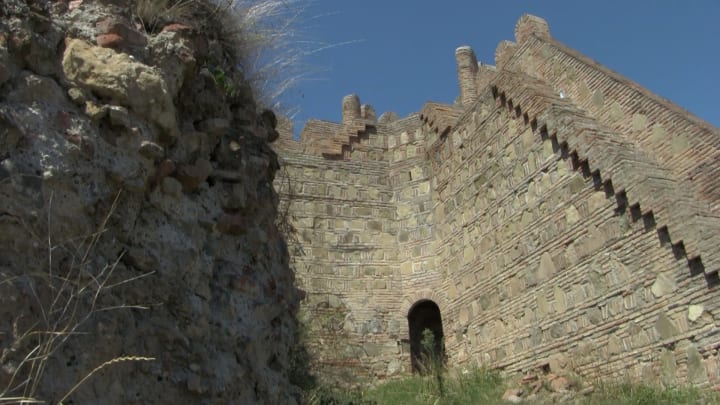
The country of Georgia, nestled between the Black and Caspian Seas, sits in the middle of a region known as The Caucasus. It is a beautifully rugged region, where Russian aristocrats toured and sunbathed during the nineteenth and early twentieth centuries while their peasant countryman determined their bloody fate. It is one of the most diverse regions on earth due to the collision of eastern and western traditions.
It is a filmmaker’s dream, the ancient cobblestone streets and the rapid modernization growing out of the ancient traditions. There is earthiness to the place and the people. They happen to be quite warm when you meet them but seem cold and standoffish in the streets, pretty much like me. No surprise then, that I immediately fell in love with Tbilisi and seriously contemplated moving there.
There was a sense of danger though. Rampant corruption had left car sized holes in some of the streets and just a few years prior to my arrival, Russia and Georgia had been at war. It was a somewhat risky country to visit at that time. I believe the security there has since improved, though I’m not sure about the corruption. Still, everywhere you looked, there was a story. I know that can be said about most anywhere, but when you find yourself in a place as ancient and diverse as Georgia, you do see the difference that centuries and millennia can make. Those walls and streets speak, if you’re listening.
While exotic places are certainly not a requirement for shooting a documentary, or anything for that matter, there is something to be said about going somewhere outside of your comfort zone. As filmmakers, we are born observers and there is a lot to be gained when one observes a place that is foreign to them. Werner Herzog has done this to great effect on many occasions, and perhaps his filmmaking adventures inspired me to embark on one of my own.
The Pitch...or, "Who are you again?"
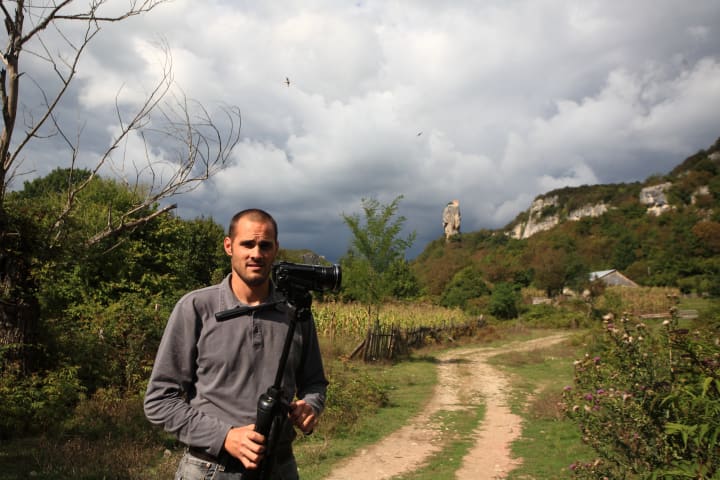
After a few days in Tbilisi, it was time to meet with the Georgian National Film Center, GNFC for short. The office stood in an older nondescript building that looked like an apartment complex from the seventies. The inside, however, was modern and well decorated. This was a theme I noticed in Tbilisi. My hostel was no different, the outside looked suspect while the inside was quite nice.
Temo and I checked in with the receptionist and we were taken to a conference room with about four other people. They all spoke English and I handed them a proposal that my collaborators back in the states and I put together. I gave them some quick background and tried to present the vision as vividly as I possibly could, lobbing adjective after adjective at them in a descriptive shelling. This was another huge step outside of my comfort zone, and I know it showed.
After a few hurried minutes laying siege to the minds of complete strangers, one of them looked up and literally said, “I’m sorry, but who are you again? What movies have you made?” I stammered, then recovered and told them about my biggest project to date, a longer short film (that has never been released) which cost me (and two others) close to $5,000 to make. As expected, they weren’t interested in a co-production deal with a no name American who only had a handful of shorts and internet commercials to his name.
The meeting wasn’t all a waste though. They provided me with some great insight regarding the need to bring on a line producer, as well as some potential contacts. Probably the biggest take away for me was, I put myself in a situation that I couldn’t run away from or avoid. I forced my own hand and got in some practice trying to pitch film industry gate keepers. Even though the gates they were keeping happened to be Georgian.
It scared the shit out of me though, and I know that I royally bombed that meeting. To the effect of becoming an office joke at the GNFC for years to come. But you can bet your ass that I have learned from that experience and will be far better prepared for my next pitch. As countless motivational speakers have said, in one form or another, it is never wasteful to challenge yourself, even if you fail. Especially when you fail.
Religious Experience of an Irreligious Man
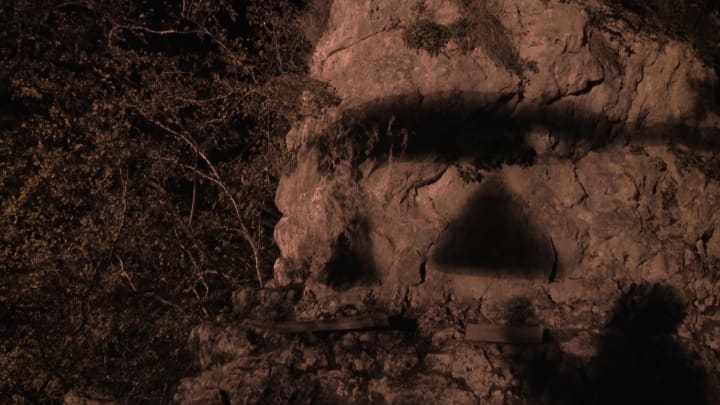
I’m an Agnostic by way of liberal Catholicism and university Atheism. I’ve since concluded that the most intellectually honest position for myself is to accept that we just don’t know, and whatever “knowing” there is, can only be based on faith and/or belief. Don’t get me wrong though, I’m deeply interested in religious history and faith itself, which is what brought me to Georgia in the first place. But my pilgrimage to Katskhi Pillar was creative and not religious, though I would argue that both are equally spiritual.
When we finally arrived in Katskhi Village, some three hours by car from Tbilisi, I was quite shocked by how primitive the roads were. The village sat on a hill with a church at its base. A rock covered path carved into the slope by hundreds of years of travel connected them. Temo owned a small Isuzu SUV that to my amazement, could go almost anywhere. There were some slopes that seemed to be a sixty-degree grade which, after some careful gear work, he was able to traverse.
My first glimpse of the pillar was from a field on the “road” up through the village. There it stood, jutting from the forest below, as if the hermitage on top was what kept it perfectly balanced and still standing. The surrounding valley had countless caves in which various hermits have lived for centuries. Even today, you can find grapevines growing out of handmade stucco walls built onto many of the caves.
We planned to head to the pillar after setting up in a small dacha owned by a few of Temo’s rock climbing buddies. It was bare bones, they treated it as a place to just sleep and prepare for a day of climbing on the limestone cliffs in the area. Nobody lived there, and the mattresses on the rusting metal beds that filled the main room were beginning to molder. Let’s just say that I was thankful for the Georgian army surplus sleeping bag I purchased at a swap meet a few days before.
My first meeting with Father Maxim took place that evening. He was not on the pillar but sitting on a wooden chair beneath the awning of one of the buildings below. As we approached him, it was clear that he remembered Temo.
When Temo introduced me, I heard the word “Cathlicos”. I had previously shared with him that I was raised a Catholic. Obviously, Father Maxim had asked Temo if I was a believer or perhaps even asked if I was Orthodox. Either way, I heard “Cathlicos” and began to panic. I was worried that the thousand years of animosity between the two traditions would destroy any rapport that we might build over the next few days.
Thankfully, my concern was stereotypical and unfounded. My impression of Father Maxim was that he was surprisingly down to earth. I expected him to be a stern monk looking down at us for the way that we were living our lives. Or perhaps, I wondered, he might be irritated with us and our questions. But instead he was quite jovial, laughed often, and seemed eager to speak with us. He was reluctant however, to speak too much about himself. He seemed to be a very humble man. After a short conversation, he asked if I wanted to ascend the pillar.
It was close to sunset when I began to climb the iron ladder bolted into the rock. I’m not usually afraid of heights, but it was nerve wracking. It seemed like forever, as I climbed one hundred thirty feet wrung by wrung. When I finally pulled myself up after what felt like fifteen minutes of climbing, I looked down. Temo and Father Maxim were sitting below talking. It was surreal though, I couldn’t hear a thing, not even a murmur from below. All I could hear was the wind rustling through leaves and an old bell rubbing on its hinges.
I sat down on a small rock wall to get my camera out of my backpack and suddenly felt a strange sensation that I can only describe as the Self beginning to minimize. I had experienced this phenomenon only two other times in my life; once in Japan, when I was sitting on a rock near the summit of Mt. Fuji and watching the sun rise while drawing the mist out of the surrounding valleys, and about eight years later when my siblings and I prepared our mother for burial.
We spent the next five or six days trekking around the pillar, meeting various villagers, and working with the monks. They invited us on several occasions to dine with them. Half of one day was dedicated to helping gather clay roof tiles donated by the villagers nearby. They would be used to roof the new buildings at the monastery. This was likely the single most important thing we could have done to ensure their trust, which allowed us to document their day to day lives. They even allowed us to film their services, which Temo shot beautifully.
Missing the Boat While on the Dock
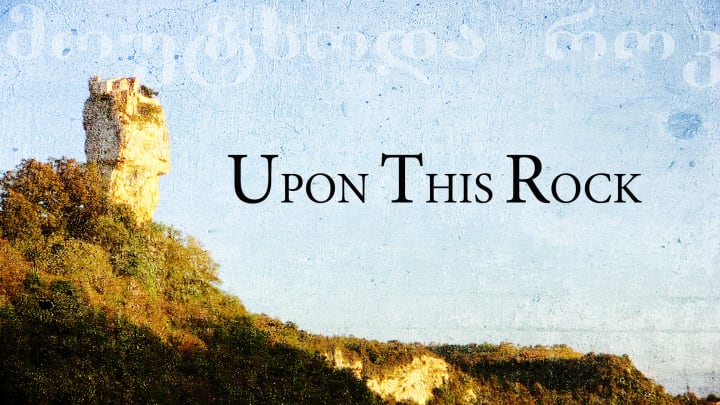
I returned from Georgia with hours of footage and a trailer that was almost complete. With all the footage that we shot, I knew that there was a short prologue in it. I even picked a name straight out of the Bible for it, Upon This Rock. It took many more months however, for the short to take shape. Doing the subtitles alone was a huge undertaking and during that process, I vowed to never do it myself again.
We completed the short in about six months and submitted to Sundance. It was the first time I had ever submitted anything. In fact, I had to be talked into doing so. Sure, I was proud of the film, but I just didn’t think we had a chance.
Months later, I was contacted by one of the short subject programmers. He praised our film but asked if I could send a shorter version. Stupidly, what I sent was a little over thirty minutes. Any film website out there will tell you that your film better be top notch if you expect a premiere festival to pick your thirty-minute opus over three ten-minute films. Still, I was shocked that we didn’t just get a rejection letter.
I immediately began pruning and ended up cutting about ten minutes before I felt like another cut would harm the contemplative nature of the film. In hindsight, I know that I should have taken a chainsaw to it. It was rejected in the end, but I was still emboldened by the fact that our film made it through the initial screening stages in a pool of thousands. Take it from me though, if a major festival emails you and requests a shorter version, shred your film. Re-imagine it if you must.
Upon This Rock finally had its premiere in Los Angeles. It screened for an enthusiastic crowd, which surprised me because of its religious and contemplative nature. It is such a niche film that I thought people may not respond to it in a festival setting. Although the film had a religious topic, we filmed it simply and straight forward to be presented as an observational experience of a tradition that is quite foreign to some Americans.
After the screening, we went to work on the release, but we were not fast enough. About five months after the premiere, the media started to pick up Father Maxim’s story. CNN and the Huffington Post ran some high-profile articles. The Huffington Post reached out to me and linked to our trailer. Even Fuji TV in Japan emailed to ask how much we wanted for some of our footage. I was completely out of my element, having never sold stock footage before. My main concern was not money however, but credit. Strangely, they didn’t want to give it, so negotiations broke down.
Nevertheless, we saw the views of our trailer skyrocket and people were asking how they could purchase the film. It was obvious that there was interest, but we were just not ready to release it. There is no doubt in my mind that had we been prepared, we would have certainly made back the money that was invested. As independent filmmakers, it’s not every day, in fact there’s rarely a day, when that can be said with a straight face.
In the end, we were about four months too late. We did get a steady stream of orders, but the interest in the story generated by the media had dissipated by then. This experience has taught us to be more strategic and consistent with our releases. Although it was a giant missed opportunity, we have taken it to heart and streamlined our processes. Ultimately though, you just never know if your little niche film will accidentally tap into a piece of the zeitgeist. My advice gleaned from this experience? It’s always best to be prepared for your film to blow up just as we are naturally prepared for it to fail.
The process of independently producing and distributing Upon This Rock took in total, about three years. To be honest though, had we been more disciplined during post production, it would have taken a lot less time. There is still much to do however, as Upon This Rock is only the beginning. It is just the prologue to the feature length creative documentary that I have always envisioned.
This experience however, has been extremely enlightening. I learned that you should never sell yourself short when it comes to the premiere festivals like Sundance, Toronto, or even Cannes. Sure, it’s extremely difficult to break through, but your film might just make the cut. It would be a shame to not even give yourself that chance.
At the same time, we don’t have to get too bummed out if our films are not picked up by major festivals, or any festival for that matter. Thanks to the VOD revolution, it is becoming easier and easier for indie films to find an audience outside of traditional distribution channels. It is a double-edged sword though, because the market is becoming more saturated every day. But if we take the time to find and cultivate our unique creative voices, we will inevitably begin to stand out from the pack.
After making our small niche film about a monk resurrecting an ancient act of devotion in a country most people confuse with a state in the US, I was surprised by the response. Witnessing the interest that this monk’s story has generated worldwide is still shocking to me. While we certainly could have better positioned ourselves when the mainstream media picked up his story, we still receive inquiries because someone has randomly stumbled onto one of those old articles. For these reasons, I firmly believe that there is an audience for anything, as long as the work is created with care, passion, and honesty.
About the Creator
Stephen Riehl
Independent filmmaker based in the Pacific Northwest dedicated to creating works that reflect the inner life.



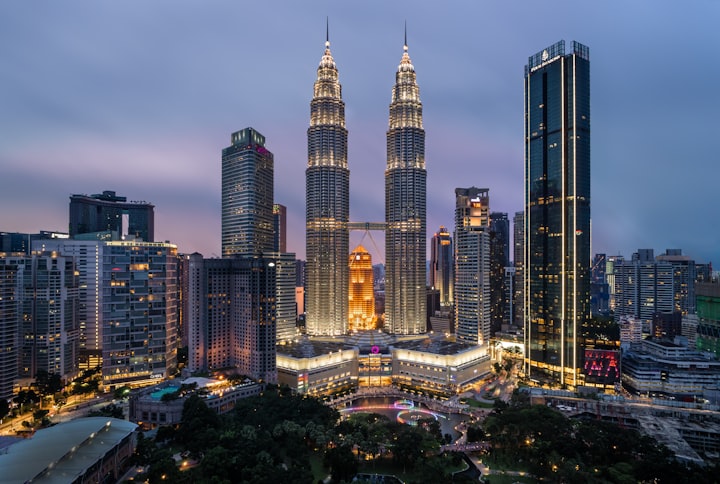


Comments
There are no comments for this story
Be the first to respond and start the conversation.